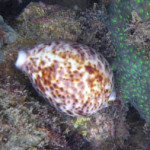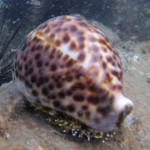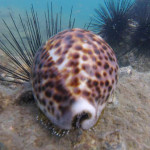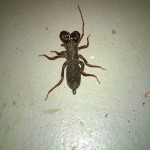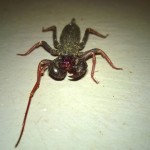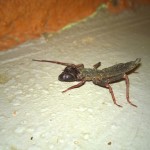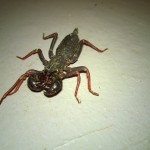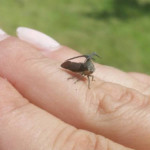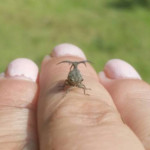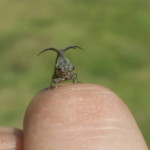Nettle Caterpillar (Parasa lepida)
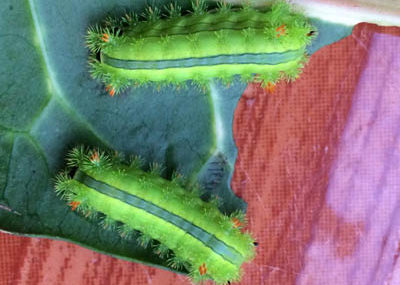 Last Observed: March 2016 – Koh Chang
Last Observed: March 2016 – Koh Chang
Last Observed By: Hans Henrik Hansen
The nettle caterpillar is a bright green caterpillar with a dark green stripe that eventually devlops into a brown and green moth.
It’s larvae are considered to be pests and pose a threat to various crops such as coffee, coconut, cocoa, tea nad mango.
Nettle Caterpillar Wikipedia
Tiger Cowrie (Cypraea tigris)
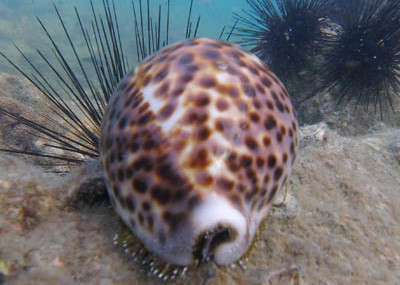
Image Copyright Paul Dunn
Last Observed: November 2015
Observed By: Paul Dunn
The tiger cowrie is a large mollusc with a characteristic and much-prized spotted brown and white shell that can measure up to six inches in length.
It is a widespread species being found on the ocean floor all across the Indo-Pacific region.
Adult tiger cowries feed on coral and invertebrates whilst juveniles feed on algae.
Tiger Cowrie Wikipedia
Image Copyright Paul Dunn
Image Copyright Paul Dunn
Image Copyright Paul Dunn
Vinegaroon (Telephonida)
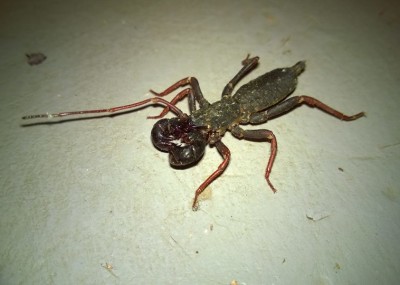
Image Copyright Napha Kotkanplu
Last Observed: January 2016, Koh Chang
Observed By: Napha Kotkangplu
The Vinegaroons, also known as whip scorpions are in fact a family of arachnids that is completely separate from scorpions themselves.
They get their rather marvellous name from an ability they have when attacked to discharge a pungent liquid that contains acetic acid and smells like vinegar.
As you can tell from their fearsome pincers vinegaroons are formidable predators that feed on insects, millipedes, scorpions and even small vertebrates. They kill their prey by crushing them and are particularly fond of cockroaches.
Vinegaroon Wikipedia
Image Copyright Napha Kotkanplu
Image Copyright Napha Kotkanplu
Image Copyright Napha Kotkanplu
Image Copyright Napha Kotkanplu
Umbelligerus peruviensis
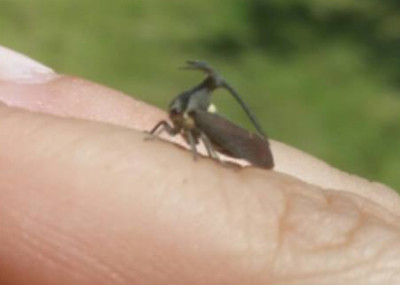
Image Copyright Rinske Hackman
Last Observed: February 2016, Koh Chang
Observed By: Rinske Hackman
The unique three pronged “antlers” that sprout from the head of this bizarre insect are almost like a helicopter’s rotor blades. They don’t turn of course. This fly gets around using its wings and the internet is unusually circumspect regarding what on earth the blades are for.
So I’m going to guess that they offer protection from predators by camouflage. Or maybe they are used in display to win potential mates? Or perhaps they are used to fight off other Umbelligerus peruviensis? Maybe the fly is wearing them for a bet? If you know please pass on a scientific answer.
Umbelligeris peruviensis National Geographic
Image Copyright Rinske Hackman
Image Copyright Rinske Hackman
Image Copyright Rinske Hackman
Thiania bhamoensis
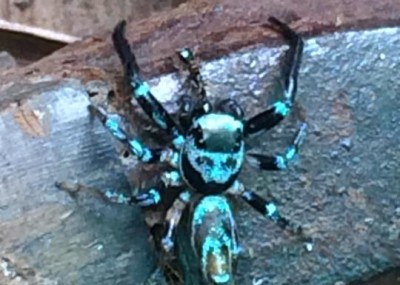
Image Copyright Hans Henrik Hansen
Last Observed: January 2016 – Koh Chang
Observed By: Hans Henrik Hansen
Thiania bhamoensis is a small and brilliantly blue and black coloured little species of jumping spider.
These spiders build lairs by using their silk to bind two green leaves together. They build these nests on many species of plants but most commonly on the aptly named spider lily.
In Southeast Asia these spiders are also known as the fighting spider because two males will always fight each other when placed in close proximity. So of course people fight them for sport – you’d think there would be something better to do – but never make the mistake of overestimating human nature.
Thiania bhamoensis Wikipedia
Micronia Aculeata
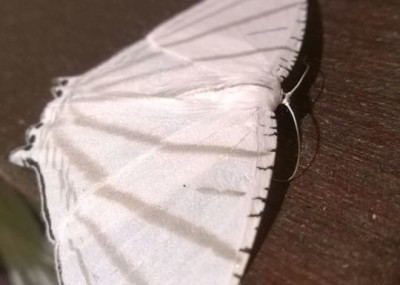
Image Copyright Napha Kotkangplu
Last Observed: February 2016, Koh Chang
Observed By: Napha Kotkangplu
Okay let’s be honest here. This moth might not actually be micronia aculeata, a moth that is apparently found in India and Sri Lanka. Hard to tell though, it certainly looks extremely similar so at worst it’s a very close relative. And the internet has so much different and often contradictory information that identifying animals – particularly insects – extra particularly butterflies and moths is a nightmare. So it’s Micronia aculeata until an expert tells us otherwise. Okay?
Micronia Aculeata Wikipedia
Masked Hunter (Reduvius personatus)
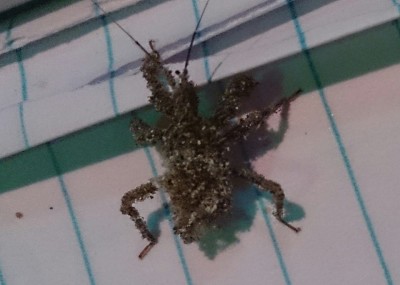
Image Copyright Lena Abi Chaker
Last Observed: February 2016, Koh Chang
Observed By: Lena Abi Chaker
The masked hunter is a small predatory member of the assasin bug family of insects. It’s another of those “you won’t believe it animals” that Koh Chang seems to specialise in. The photograph isn’t blurred, oh no. The sneaky masked hunter camouflages itself by covering its shell with dust, dirt and small particles of matter. Then it pounces on its unsuspecting prey ot woodlice, lacewings and other smaller insects. It also eats bedbugs in case you require a redeeming feature.
They apparently have a very painful bite which they can use in self defense – but fear not there’s no poison – for a change.
Masked Hunter Wikipedia
Jewel Beetle (Chrysocroa fulgens)
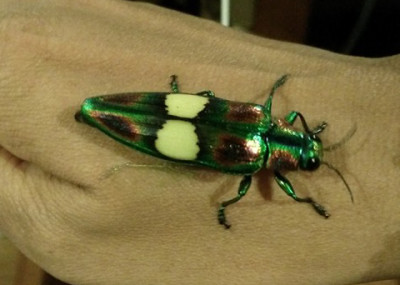
Image Copyright Paweena Khamsap
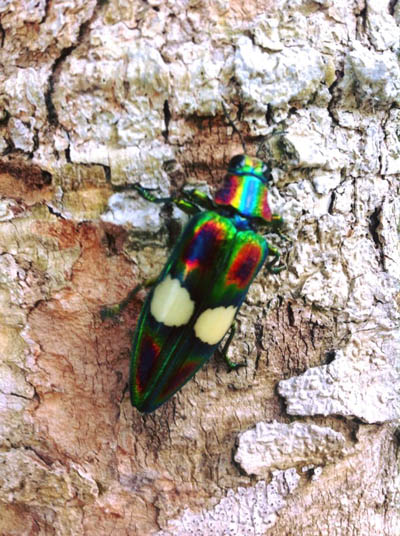
Image Copyright Nattapol Phutong
Last Observed: February 2016, Koh Chang
Observed By: Paweena Khamsap, Nattapol Phutong
The Jewel Beetle family are also known as the metallic wood boring beetles. Both names refer to their incredible iridescent shell which has a brilliantly coloured metallic sheen, and in the case of this species two ivory-coloured spots on the back.
Jewel Beetle Weevil Coleoptera-Atlas.com
Red Palm Weevil (Rhynchophorus ferrugineus)
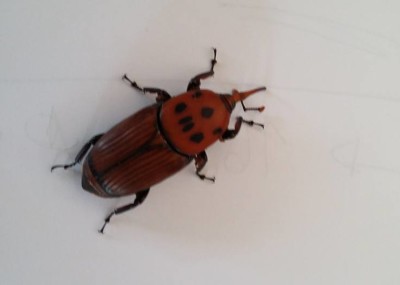
Image Copyright Jean-Pierre Odet
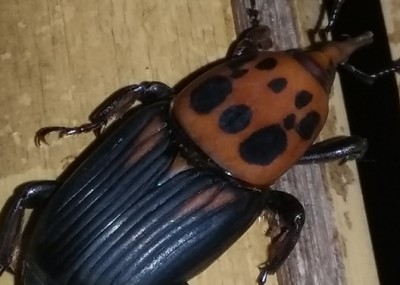
Image Copyright Jean-Pierre Odet
Last Observed: February 2016, Koh Chang
Observed By: Jean-Pierre Odet
The red palm weevil is a long-snouted brown and black beetle that grows up to 5cm in length.
They excavate holes in palm trees that can result in their death and they are considered a major pest in commercial palm plantations.
Red Palm Weevil Wikipedia
Dundubia spiculata
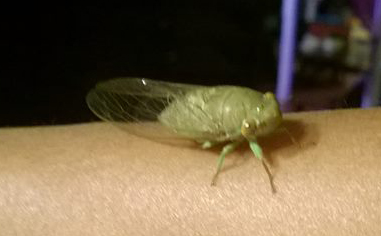
Image Copyright Napha Kotkangplu
Observed: February 2016
Observed By: Napha Kotkangplu
Dundubia spiculata is a species of Cicada found on Koh Chang. If you hear an unholy screeching racket round about sunset it might be this fellow setting up a hullabaloo with his wings.
 Last Observed: March 2016 – Koh Chang
Last Observed: March 2016 – Koh Chang

